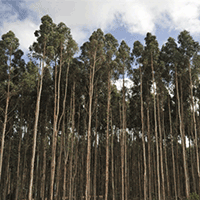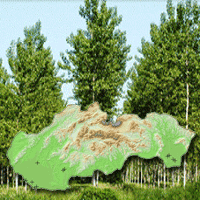Modern forestry is gradually moving towards man-made forests on a large scale. Plantations with advanced forestry system have been introduced with the goal of sustainable forestry development and to enhance social, ecological, and economic benefits. Forest plantations with native and exotic species have been established in China and worldwide with shorter rotation cycles than natural forests. In this paper, we discuss the role and perspectives of plantation forests in the Chinese sustainable forest development, the evolution of various plantation programs, the ecological effects of plantations, and the measures to improve plantation forestry. The Chinese government has given substantial importance to nurturing plantation forest resources through various large scale afforestation programs. In 2019, the total area covered by plantations in China reached 79.54 million ha, with a stock volume of 3.39 billion m³ (59.30 m³ per ha); coniferous forests (26.11 million ha, 32.83%) and broad-leaved forests (26.45 million ha, 33.25%) are the dominant types. Plantations have been primarily distributed in the central and southern parts of the country. Plantations with fast-growing and high-yielding tree species facilitated Chinese afforestation activities and improved the administration of forest production, which effectively boosted the forest industry. Plantation forest resources offer many potential productive, economic, and social advantages, though they are also associated with a loss of biodiversity and climate change makes them likely susceptible to disease and insect attack. Appropriate forest management practices during planning, execution, and maintenance of plantations can contribute to the conservation, promotion, and restoration of biodiversity, with the final aim of attaining a balance between having forest plantations and natural forests.
Keywords
, , , ,
Citation
Farooq TH, Shakoor A, Wu X, Li Y, Rashid MHU, Zhang X, Gilani MM, Kumar U, Chen X, Yan W (2021). Perspectives of plantation forests in the sustainable forest development of China. iForest 14: 166-174. - doi: 10.3832/ifor3551-014
Academic Editor
Giorgio Vacchiano
Paper history
Received: Jun 12, 2020
Accepted: Jan 29, 2021
First online: Apr 09, 2021
Publication Date: Apr 30, 2021
Publication Time: 2.33 months
© SISEF - The Italian Society of Silviculture and Forest Ecology 2021
Open Access
This article is distributed under the terms of the Creative Commons Attribution-Non Commercial 4.0 International (https://creativecommons.org/licenses/by-nc/4.0/), which permits unrestricted use, distribution, and reproduction in any medium, provided you give appropriate credit to the original author(s) and the source, provide a link to the Creative Commons license, and indicate if changes were made.

Breakdown by View Type
(Waiting for server response...)
Article Usage
Total Article Views: 51831
(from publication date up to now)
Breakdown by View Type
HTML Page Views: 40804
Abstract Page Views: 5947
PDF Downloads: 4372
Citation/Reference Downloads: 35
XML Downloads: 673
Web Metrics
Days since publication: 1715
Overall contacts: 51831
Avg. contacts per week: 211.56
Article Citations
Article citations are based on data periodically collected from the Clarivate Web of Science web site
(last update: Mar 2025)
Total number of cites (since 2021): 45
Average cites per year: 9.00
Publication Metrics
by Dimensions ©
Articles citing this article
List of the papers citing this article based on CrossRef Cited-by.
(1)
Abella SR, Craig DJ, Smith SD, Newton AC (2012)Identifying native vegetation for reducing exotic species during the restoration of desert ecosystems. Restoration Ecology 20 (6): 781-787.
CrossRef |
Gscholar
(2)
Abreu RC, Assis GB, Frison S, Aguirre A, Durigan G (2011)Can native vegetation recover after slash pine cultivation in the Brazilian Savanna? Forest Ecology and Management 262 (8): 1452-1459.
CrossRef |
Gscholar
(3)
Araujo AS, Silva EF, Nunes LA, Carneiro RF (2010)The effect of converting tropical native savanna to
Eucalyptus grandis forest on soil microbial biomass. Land Degradation and Development 21 (6): 540-545.
CrossRef |
Gscholar
(4)
Aronson J, Alexander S (2013)Ecosystem restoration is now a global priority: time to roll up our sleeves. Restoration Ecology 21 (3): 293-296.
CrossRef |
Gscholar
(5)
Avtar R, Suzuki R, Sawada H (2014)Natural forest biomass estimation based on plantation information using PALSAR data. PLoS One 9 (1): e86121.
CrossRef |
Gscholar
(6)
Bao F, Jiang Z (1994)Studies on the properties of wood from fast-growing forest plantations. World Forestry Research, Ministry of Forestry, Beijing, China, vol. 7, pp. 340. [In Chinese]
Gscholar
(7)
Bao F, Jiang Z (1998)Wood properties of main tree species from plantation in China. Forestry Publishing House, Beijing, China, pp. 170. [In Chinese]
Gscholar
(8)
Bao FC, Lu JX (1998)The change in wood resources structure and the strategies for wood science research in China. Chinese Academy of Forestry, China Agricultural Science and Technology Press, Beijing, China, pp. 503-509. [In Chinese]
Gscholar
(9)
Barr C, Cossalter C (2004)China’s development of a plantation-based wood pulp industry: government policies, financial incentives, and investment trends. The International Forestry Review 6 (3-4): 267-281.
CrossRef |
Gscholar
(10)
Bhardwaj D, Ansari MW, Sahoo RK, Tuteja N (2014)Biofertilizers function as key player in sustainable agriculture by improving soil fertility, plant tolerance and crop productivity. Microbial Cell Factories 13 (1): 66.
CrossRef |
Gscholar
(11)
Brockerhoff EG, Jactel H, Parrotta JA, Quine CP, Sayer J (2008)Plantation forests and biodiversity: oxymoron or opportunity? Biodiversity and Conservation 17 (5): 925-951.
CrossRef |
Gscholar
(12)
Brockerhoff EG, Jactel H, Parrotta JA, Ferraz SF (2013)Role of eucalypts and other planted forests in biodiversity conservation and the provision of biodiversity-related ecosystem services. Forest Ecology and Management 1 (301): 43-50.
CrossRef |
Gscholar
(13)
Carnus JM, Parrotta J, Brockerhoff E, Arbez M, Jactel H, Kremer A, Lamb D, O’Hara K, Walters B (2006)Planted forests and biodiversity. Journal of Forestry 104 (2): 65-77.
Online |
Gscholar
(14)
Carrara LA, Faria LC, Antas PD, De Matos JR, Sartorio RC, Scopel ET (2010)Commercial Eucalyptus plantation as communal night roosts of parrots
Amazona spp.: selective convergence. Revista Brasileira de Ornitología 18 (1): 49-54.
Gscholar
(15)
Chen X, Lupi F, He G, Liu J (2009)Linking social norms to efficient conservation investment in payments for ecosystem services. Proceedings of the National Academy of Sciences USA 106 (28): 11812-11817.
CrossRef |
Gscholar
(16)
Chinnaraj S, Malimuthu C (2011)Development of micro-propagation and mini cutting protocol for fast growing
Melia, Dalbergia and
Eucalyptus clones for pulpwood and bio-energy plantations. BMC Proceedings 5 (7): 1-3.
CrossRef |
Gscholar
(17)
Corbin J, D’Antonio CM (2004)Effects of exotic species on soil nitrogen cycling: implications for restoration 1. Weed Technology 18 (sp1): 1464-1467.
CrossRef |
Gscholar
(18)
Dias T, Dukes A, Antunes PM (2015)Accounting for soil biotic effects on soil health and crop productivity in the design of crop rotations. Journal of the Science of Food and Agriculture 95 (3): 447-454.
CrossRef |
Gscholar
(19)
Dong B, Zhao K, Wang Z, Jia Z, Ma L, Xia X (2018)Forest recovery after clear-cutting in Chinese pine (
Pinus tabuliformis) plantations of North China. Journal of Arid Land 10 (2): 233-248.
CrossRef |
Gscholar
(20)
D’Amato D, Rekola M, Wan M, Cai D, Toppinen A (2017)Effects of industrial plantations on ecosystem services and livelihoods: perspectives of rural communities in China. Land Use Policy 63 (8): 266-278.
CrossRef |
Gscholar
(21)
Ehrenfeld JG (2003)Effects of exotic plant invasions on soil nutrient cycling processes. Ecosystems 6 (6): 503-23.
CrossRef |
Gscholar
(22)
Erskine PD, Lamb D, Bristow M (2006)Tree species diversity and ecosystem function: can tropical multi-species plantations generate greater productivity? Forest Ecology and Management 233 (2-3): 205-210.
CrossRef |
Gscholar
(23)
Evans J (1976)Plantations: productivity and prospects. Australian Forestry 39 (3): 150-163.
CrossRef |
Gscholar
(24)
Evans J (2009)Planted forests: uses, impacts, and sustainability. Food and Agriculture Organization of the United Nations, Rome, Italy, pp. 213.
Online |
Gscholar
(25)
FAO (2011)Plantation forestry and water. The Brazilian Forests Dialogue, Rio de Janeiro, Brazil, pp. 24-25.
Gscholar
(26)
FAO (2020)State of world’s forests, annual rate of forest expansion and deforestation, 1990-2020. Web site.
Online |
Gscholar
(27)
Farooq TH, Tigabu M, Ma X, Zou X, Liu A, Odén PC, Wu P (2018)Nutrient uptake, allocation and biochemical changes in two Chinese fir cuttings under heterogeneous phosphorus supply. iForest - Biogeosciences and Forestry 11 (3): 411-417.
CrossRef |
Gscholar
(28)
Farooq TH, Yan W, Rashid MHU, Tigabu M, Gilani MM, Zou XH, Wu PF (2019a)Chinese fir (
Cunninghamia lanceolata) a green gold of China with continues decline in its productivity over the successive rotations: a review. Applied Ecology and Environmental Research 17 (5): 11055-11067.
CrossRef |
Gscholar
(29)
Farooq TH, Wu W, Tigabu M, Ma X, He Z, Rashid MHU, Gilani MM, Wu P (2019b)Growth, biomass production and root development of Chinese fir in relation to initial planting density. Forests 10 (3): 236.
CrossRef |
Gscholar
(30)
Farooq TH, Ma X, Rashid MH, Wu W, Xu J, Tarin MW, He Z, Wu P (2019c)Impact of stand density on soil quality in Chinese fir (
Cunninghamia lanceolata) monoculture. Applied Ecology and Environmental Research 17 (2): 3553-66.
CrossRef |
Gscholar
(31)
Forrester DI, Bauhus J, Cowie AL, Vanclay JK (2006)Mixed-species plantations of Eucalyptus with nitrogen-fixing trees: a review. Forest Ecology and Management 233(2-3): 211-230.
CrossRef |
Gscholar
(32)
Fox TR (2000)Sustained productivity in intensively managed forest plantations. Forest Ecology and Management 138(1-3): 187-202.
CrossRef |
Gscholar
(33)
Freer-Smith P, Muys B, Bozzano M, Drössler L, Farrelly N, Jactel H, Korhonen J, Minotta G, Nijnik M, Orazio C (2019)Plantation forests in Europe: challenges and opportunities. From Science to Policy 9, EFI, Joensuu, Finland, pp. 6-30.
CrossRef |
Gscholar
(34)
Gerber JF (2011)Conflicts over industrial tree plantations in the South: who, how and why? Global Environmental Change 21 (1): 165-176.
CrossRef |
Gscholar
(35)
Grossiord C, Granier A, Gessler A, Pollastrini M, Bonal D (2013)The influence of tree species mixture on ecosystem-level carbon accumulation and water use in a mixed boreal plantation. Forest Ecology and Management 298: 82-92.
CrossRef |
Gscholar
(36)
Hartmann H, Daoust G, Bigué B (2010)Negative or positive effects of plantation and intensive forestry on biodiversity: a matter of scale and perspective. The Forestry Chronicle 86 (3): 354-64.
CrossRef |
Gscholar
(37)
Hu YL, Wang SL, Zeng DH (2006)Effects of single Chinese fir and mixed leaf litters on soil chemical, microbial properties and soil enzyme activities. Plant and Soil 282 (1-2): 379-386.
CrossRef |
Gscholar
(38)
Larjavaara M (2008)A review on benefits and disadvantages of tree diversity. Open Forest Science Journal 1 (1): 24-26.
CrossRef |
Gscholar
(39)
Li Y, Awada T, Zhou X, Shang W, Chen Y, Zuo X, Wang S, Liu X, Feng J (2012)Mongolian pine plantations enhance soil physico-chemical properties and carbon and nitrogen capacities in semi-arid degraded sandy land in China. Applied Soil Ecology 56: 1-9.
CrossRef |
Gscholar
(40)
Li Y, Hui G, Yu S, Luo Y, Yao X, Ye S (2017)Nearest neighbour relationships in
Pinus yunnanensis var.
tenuifolia forests along the Nanpan River, China. iForest - Biogeosciences and Forestry 10 (4): 746-753.
CrossRef |
Gscholar
(41)
Li Y, He J, Lu L, Xu J, Wang H, Ye S (2020)The long-term effects of thinning and mixing on species and structural diversity of Chinese fir plantations. New Forests.
CrossRef |
Gscholar
(42)
Liao C, Luo Y, Fang C, Chen J, Li B (2012)The effects of plantation practice on soil properties based on the comparison between natural and planted forests: a meta-analysis. Global Ecology and Biogeography 21 (3): 318-27.
CrossRef |
Gscholar
(43)
Lima WD, Laprovitera R, Ferraz SF, Rodrigues CB, Silva MM (2012)Forest plantations and water consumption: a strategy for hydrosolidarity. International Journal of Forestry Research 2012: 1-8.
CrossRef |
Gscholar
(44)
Lin K, Yu XT, Huang BL, He ZY (2001)Dynamical characteristics of undergrowth plant diversity in Chinese fir plantations. Chinese Journal of Applied and Environmental Biology 7 (1): 13-19. [In Chinese]
Gscholar
(45)
Lindenmayer DB, Franklin JF, Fischer J (2006)General management principles and a checklist of strategies to guide forest biodiversity conservation. Biological conservation 131 (3): 433-45.
CrossRef |
Gscholar
(46)
Liu J, Li S, Ouyang Z, Tam C, Chen X (2008)Ecological and socioeconomic effects of China’s policies for ecosystem services. Proceedings of the National Academy of Sciences USA 105 (28): 9477-9482.
CrossRef |
Gscholar
(47)
Liu CLC, Kuchma O, Krutovsky KV (2018)Mixed-species
versus monocultures in plantation forestry: development, benefits, ecosystem services and perspectives for the future. Global Ecology and Conservation 15: e00419.
CrossRef |
Gscholar
(48)
Lü Y, Fu B, Wei W, Yu X, Sun R (2011)Major ecosystems in China: dynamics and challenges for sustainable management. Environmental Management 48 (1): 13-27.
CrossRef |
Gscholar
(49)
Ma X, Liu A, Ma Z, Fan S (2000)A comparative study on nutrient accumulation and distribution of different generations of Chinese fir plantations. The Journal of Applied Ecology 11 (4): 501-506.
Online |
Gscholar
(50)
Ma X, Heal KV, Liu A, Jarvis PG (2007)Nutrient cycling and distribution in different-aged plantations of Chinese fir in southern China. Forest Ecology and Management 243 (1): 61-74.
CrossRef |
Gscholar
(51)
Martin PS, Gheler-Costa C, Lopes PC, Rosalino LM, Verdade LM (2012)Terrestrial non-volant small mammals in agro-silvicultural landscapes of Southeastern Brazil. Forest Ecology and Management 282: 185-195.
CrossRef |
Gscholar
(52)
Mason WL, Connolly T, Pommerening A, Edwards C (2007)Spatial structure of semi-natural and plantation stands of Scots pine (
Pinus sylvestris L.) in northern Scotland. Forestry 80 (5): 567-586.
CrossRef |
Gscholar
(53)
Mayoral C, Van Breugel M, Cerezo A, Hall JS (2017)Survival and growth of five neotropical timber species in monocultures and mixtures. Forest Ecology and Management 403: 1-11.
CrossRef |
Gscholar
(54)
Miao L, Zhu F, He B, Ferrat M, Liu Q, Cao X, Cui X (2013)Synthesis of China’s land use in the past 300 years. Global and Planetery Change 100: 224-233.
CrossRef |
Gscholar
(55)
Minghe L, Ritchie GA (1999)Eight hundred years of clonal forestry in China: I. Traditional afforestation with Chinese fir (
Cunninghamia lanceolata (Lamb.) Hook.). New Forests 8 (1): 131-142.
CrossRef |
Gscholar
(56)
Oliet JA, Jacobs DF (2012)Restoring forests: advances in techniques and theory. New Forests 1 (43): 535-541.
CrossRef |
Gscholar
(57)
Paquette A, Messier C (2010)The role of plantations in managing the world’s forests in the Anthropocene. Frontiers in Ecology and the Environment 8 (1): 27-34.
CrossRef |
Gscholar
(58)
Pereira HM, Navarro LM, Martins IS (2012)Global biodiversity change: the bad, the good, and the unknown. Annual Review of Environment and Resources 37: 25-50.
CrossRef |
Gscholar
(59)
Pirard R, Dal Secco L, Warman R (2016)Do timber plantations contribute to forest conservation? Environmental Science and Policy 57: 122-130.
CrossRef |
Gscholar
(60)
Ren G, Young SS, Wang L, Wang W, Long Y, Wu R, Li J, Zhu J, Yu DW (2013)Effectiveness of China’s national forest protection program and nature reserves. Conservation Biology 29 (5): 1368-1377.
CrossRef |
Gscholar
(61)
Ruiz-Jaen MC, Potvin C (2011)Can we predict carbon stocks in tropical ecosystems from tree diversity? Comparing species and functional diversity in a plantation and a natural forest. New Phytologist 189 (4): 978-987.
CrossRef |
Gscholar
(62)
Rundel PW, Dickie IA, Richardson DM (2014)Tree invasions into treeless areas: mechanisms and ecosystem processes. Biological Invasions 16 (3): 663-675.
CrossRef |
Gscholar
(63)
Sasaki N, Yoshimoto A (2010)Benefits of tropical forest management under the new climate change agreement - A case study in Cambodia. Environmental Science and Policy 13 (5): 384-392.
CrossRef |
Gscholar
(64)
Scott DF (2005)On the hydrology of industrial timber plantations. Hydrological Processes 19 (20): 4203-6.
CrossRef |
Gscholar
(65)
Scullion JJ, Vogt KA, Drahota B, Winkler-Schor S, Lyons M (2019)Conserving the last great forests. a meta-analysis review of the drivers of intact forest loss and the policies and strategies to save them. Frontiers in Forests and Global Change 2: 62.
CrossRef |
Gscholar
(66)
Selvaraj S, Duraisamy V, Huang Z, Guo F, Ma X (2017)Influence of long-term successive rotations and stand age of Chinese fir (
Cunninghamia lanceolata) plantations on soil properties. Geoderma 306: 127-134.
CrossRef |
Gscholar
(67)
SFA (2009)Report of forest resources in China (2004-2008). China Forestry Press, Beijing, China, pp. 68.
Gscholar
(68)
SFA (2014)Report of forest resources in China (2009-2013). China Forestry Press, Beijing, China, pp. 86.
Gscholar
(69)
SFA (2019)Forest resources in China. National forestry and grassland administration press, Beijing, China, pp. 1-28.
Gscholar
(70)
Shi M, Qi J, Yin R (2016)Has China’s natural forest protection program protected forests? Heilongjiang’s experience. Forests 7(10): 218.
CrossRef |
Gscholar
(71)
Stenert C, Bacca RC, Moraes AB, De Avila AC, Maltchik L (2012)Negative effects of exotic pine invasion on macro invertebrate communities in southern Brazil coastal ponds. Marine and Freshwater Research 63 (4): 283-92.
CrossRef |
Gscholar
(72)
Stephens SS, Wagner MR (2007)Forest plantations and biodiversity: a fresh perspective. Journal of Forestry 105 (6): 307-13.
Online |
Gscholar
(73)
Tallis H, Kareiva P, Marvier M, Chang A (2008)An ecosystem services framework to support both practical conservation and economic development. Proceedings of the National Academy of Sciences USA 105 (28): 9457-9464.
CrossRef |
Gscholar
(74)
Trumbore S, Brando P, Hartmann H (2015)Forest health and global change. Science 349 (6250): 814-818.
CrossRef |
Gscholar
(75)
Wang Z, Daun C, Yuan L, Rao J, Zhou Z, Li J, Yang C, Xu W (2010)Assessment of the restoration of a degraded semi-humid evergreen broadleaf forest ecosystem by combined single-indicator and comprehensive model method. Ecological Engineering 36 (6): 757-767.
CrossRef |
Gscholar
(76)
Wang Z, Yang H, Dong B, Zhou M, Ma L, Jia Z, Duan J (2017)Regeneration response to canopy gap size in a Chinese pine plantation: species diversity patterns, size structures and spatial distributions. Forest Ecology and Management 397: 97-107.
CrossRef |
Gscholar
(77)
Wendland KJ, Honzák M, Portela R, Vitale B, Rubinoff S, Randrianarisoa J (2010)Targeting and implementing payments for ecosystem services: opportunities for bundling biodiversity conservation with carbon and water services in Madagascar. Ecological Economics 69 (11): 2093-2107.
CrossRef |
Gscholar
(78)
Whitehead D, Beadle CL (2004)Physiological regulation of productivity and water use in Eucalyptus: a review. Forest Ecology and Management 193 (1-2): 113-140.
CrossRef |
Gscholar
(79)
Widenfalk O, Weslien J (2009)Plant species richness in managed boreal forests effects of stand succession and thinning. Forest Ecology and Management 257 (5): 1386-1394.
CrossRef |
Gscholar
(80)
Wu Z, Zhou C, Zhou X, Hu X, Gan J (2018)Variability after 15 years of vegetation recovery in natural secondary forest with timber harvesting at different intensities in southeastern China: community diversity and stability. Forests 9 (1): 40.
CrossRef |
Gscholar
(81)
Wunder S, Engel S, Pagiola S (2008)Taking stock: A comparative analysis of payments for environmental services programs in developed and developing countries. Ecological Economics 65 (4): 834-852.
CrossRef |
Gscholar
(82)
Xu J (2011)China’s new forests aren’t as green as they seem. Nature 477 (7365): 371.
CrossRef |
Gscholar
(83)
Xu J, Zhang Z, Liu W, McGowan PJK (2012)A review and assessment of nature reserve policy in China: advances, challenges and opportunities. Oryx 46 (4): 554-562.
CrossRef |
Gscholar
(84)
Yamagawa H, Ito S, Nakao T (2010)Restoration of semi-natural forest after clear-cutting of conifer plantations in Japan. Landscape and Ecological Engineering 6 (1): 109.
CrossRef |
Gscholar
(85)
Yang Y, He Z, Zou S, Yu X (1998)A study on the soil microbes and biochemistry of rhizospheric and total soil in natural forest and plantation of
Castanopsis kauakamii. Acta Ecologica Sinica 18 (2): 198-202. [In Chinese]
Gscholar
(86)
Yang X, Jia Z, Ci L (2010)Assessing effects of afforestation projects in China. Nature 466 (7304): 315.
CrossRef |
Gscholar
(87)
Yin RS, Xu JT, Li Z, Liu C (2005)China’s ecological rehabilitation: the unprecedented efforts and dramatic impacts of reforestation and slope protection in western China. China Environment Series 7 (23): 17-32.
Gscholar
(88)
You C, Jiang L, Xi F, Wang W, Li M, Xu Z, Gu L, Wang F, Zhang Z (2015)Comparative evaluation of different types of soil conditioners with respect to their ability to remediate consecutive tobacco monoculture soil. International Journal of Agriculture and Biology 17 (5): 969-975.
CrossRef |
Gscholar
(89)
Yu D, Zhou L, Zhou W, Ding H, Wang Q, Wang Y, Wu X, Dai L (2011)Forest management in Northeast China: history, problems, and challenges. Environmental Management 48 (6): 1122-1135.
CrossRef |
Gscholar
(90)
Zemp DC, Ehbrecht M, Seidel D, Ammer C, Craven D, Erkelenz J, Irawan B, Sundawati L, Hölscher D, Kreft H (2019)Mixed-species tree plantings enhance structural complexity in oil palm plantations. Agriculture, Ecosystems and Environment 1 (283): 106564.
CrossRef |
Gscholar
(91)
Zeng W, Tomppo E, Healey SP, Gadow KV (2015)The national forest inventory in China: history -results - international context. Forest Ecosystem 2 (1): 23.
CrossRef |
Gscholar
(92)
Zhang B, Li W, Xie G (2010)Ecosystem services research in China: progress and perspective. Ecological Economics 69 (7): 1389-1395.
CrossRef |
Gscholar
(93)
Zhang Y, Chen HY, Reich PB (2012)Forest productivity increases with evenness, species richness and trait variation: a global meta-analysis. Journal of Ecology 100 (3): 742-749.
CrossRef |
Gscholar
(94)
Zhang D, Stenger A, Harou PA (2015)Policy instruments for developing planted forests: Theory and practices in China, the US, Brazil, and France. Journal of Forest Economics 21 (4): 223-237.
CrossRef |
Gscholar
(95)
Zhang Y, Peng C, Li W, Tian L, Zhu Q, Chen H, Fang X, Zhang G, Liu G, Mu X (2016)Multiple afforestation programs accelerate the greenness in the “Three North” region of China from 1982 to 2013. Ecological Indicators 61 (2): 404-412.
CrossRef |
Gscholar
(96)
Zhao T (1988)The change of ecological conditions in Eucalyptus plantation. Forestry Science and Technology of Yunnan Province 88 (4): 22. [In Chinese]
Gscholar
(97)
Zhou G, Wei X, Yan J (2002)Impacts of Eucalyptus (
Eucalyptus exserta) plantation on sediment yield in Guangdong Province, southern China: a kinetic energy approach. Catena 49 (3): 231-51.
CrossRef |
Gscholar
(98)
Zhou L, Shalom A-DD, Wu P, Li S, Jia Y, Ma X (2015)Litterfall production and nutrient return in different-aged Chinese fir (
Cunninghamia lanceolata) plantations in South China. Journal of Forestry Research 26 (1): 79-89.
CrossRef |
Gscholar
(99)
Zhou H, Meng S, Liu Q (2016)Diameter growth, biological rotation age and biomass of Chinese fir in burning and clearing site preparations in subtropical China. Forests 7 (8): 177.
CrossRef |
Gscholar


















